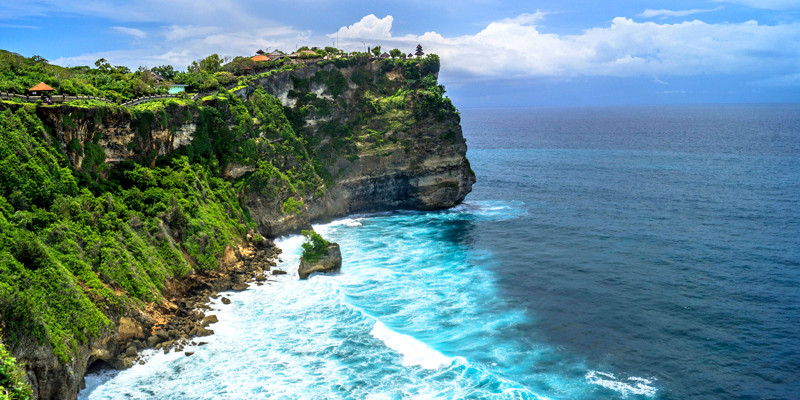Tanah Lot Temple
Tanah Lot Temple, known as Pura Tanah Lot, is one of the most famous and photographed temples in Bali. Here's a summary that captures its essence:

Historical Significance
-
Cultural Icon: As one of Bali's seven sea temples, Tanah Lot is a critical cultural landmark, each temple within eyesight of the next to form a spiritual chain along the coast.
-
Mythology: Local folklore is rich with stories of Tanah Lot, including tales of the guardian sea snakes and the revered Dang Hyang Nirartha, who is said to have established the temple.
-
Pilgrimage Site: It continues to be a place of pilgrimage for Balinese Hindus, symbolizing the balance between male and female energies, the sea and the land, and spirituality and the natural world.
Tourism and Activities
-
Photography: Known for its picturesque sunset views, Tanah Lot offers one of the most popular photographic opportunities in Bali.
-
Cultural Experience: Visitors can explore the cultural park, watch dance performances, and learn about Balinese mythology.
- Market Stalls: The area surrounding the temple features market stalls where you can buy souvenirs and local handicrafts.
Conservation Efforts
-
Preservation: The temple's rock base has undergone preservation efforts due to erosion, including the use of artificial rock to support the temple's foundation.
-
Marine Tidal Influence: The natural processes that affect Tanah Lot, including high tides that isolate the temple from the mainland, are closely monitored to balance tourist access and conservation.
Religious Practices
-
Sacred Rituals: The temple is still active, with locals coming to perform rituals, particularly during its anniversary, which occurs every 210 days according to the Balinese Pawukon calendar.
Visitor Information
-
Dress Code: Respectful attire is expected; however, the strictness is moderate since the main temple area is usually not accessible to tourists.
-
Entrance Fees: There is a fee for visitors, which is used for maintenance and local community support.
-
Tides: Access to the temple is highly dependent on the tides, so planning a visit around the tide schedule is essential.
Tanah Lot Temple offers not only a spiritual experience but also a chance to witness the natural beauty and cultural richness of Bali. It’s a symbol of Balinese identity and a testament to the island's reverence for the sacred relationship between nature and spirituality.
Uluwatu Temple
Uluwatu Temple, known locally as Pura Luhur Uluwatu, is one of Bali's most iconic and sacred temples. It is perched on a cliff approximately 70 meters above sea level, offering spectacular views of the Indian Ocean and Bali's famous sunsets. This location, on the southwestern tip of the Bukit Peninsula of Bali, Indonesia, adds to the dramatic appeal of the temple. Here are some key points about Uluwatu Temple:
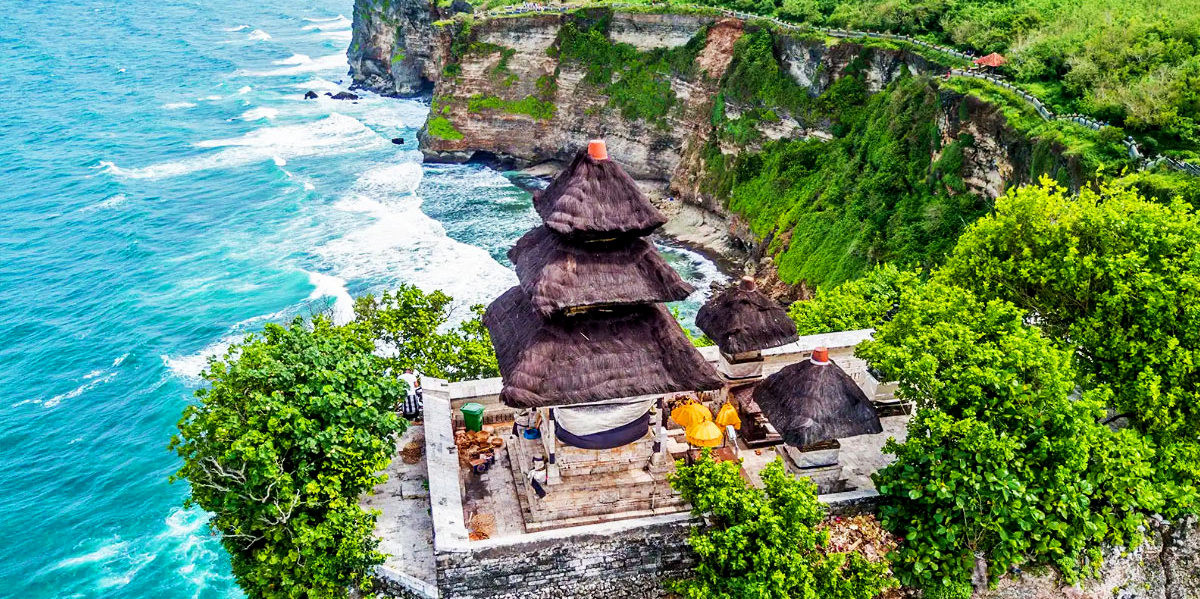
Historical Significance
-
Cultural Heritage: The temple is one of six key temples believed to be Bali's spiritual pillars and is renowned for its magnificent location, perched on top of a cliff that towers above the sea.
-
Dedication: It is dedicated to Sang Hyang Widhi Wasa in his manifestation as Rudra, the Balinese Hindu deity of the wind, and is believed to protect Bali from evil sea spirits.
-
Architecture: Balinese architecture is evident in the temple's construction, featuring traditional gateways and ancient sculptures, some of which are over a thousand years old.
Tourism and Activities
-
Kecak Fire Dance: Uluwatu Temple is famous for its Kecak fire dances, which are performed by local dancers at sunset. This is a must-see cultural performance that tells the story of the Ramayana epic through dance and music.
-
Sunset Views: The temple is a popular spot for tourists to view the sunset over the Indian Ocean, which is often considered one of the highlights of a visit to Bali.
-
Surfing: The beaches below the temple are known for some of the best surfing spots in Bali.
Conservation Efforts
-
Monkey Forest: The temple is also known for the small forest that lies at its entrance and is inhabited by monkeys. These monkeys are considered sacred and are well-known for their mischievous behavior, often taking items from unwary visitors.
-
Preservation: The temple is a protected cultural and archaeological site, and there are ongoing efforts to preserve its historical and cultural integrity against the challenges of tourism and environmental wear.
Religious Practices
-
Ceremonies and Festivals: Uluwatu Temple is an active place of worship. Balinese Hindus visit the temple to pray and perform religious ceremonies, especially during its anniversary celebration, which takes place according to the Balinese 210-day Pawukon calendar.
Visitor Information
Visiting Uluwatu Temple is not just about seeing the structure itself, but also about experiencing the cultural and spiritual essence that it embodies. It's an integral part of the Balinese culture and offers insight into the island's deep-rooted religious traditions.
Ulun Danu Beratan Temple
Ulun Danu Beratan Temple, commonly referred to as Pura Ulun Danu Bratan, is a picturesque landmark situated on the western shore of Lake Bratan in the mountains near Bedugul in Bali, Indonesia. This temple is one of the island's most iconic sanctuaries due to its scenic location on the water and its significance in Balinese culture. Here is a detailed overview:
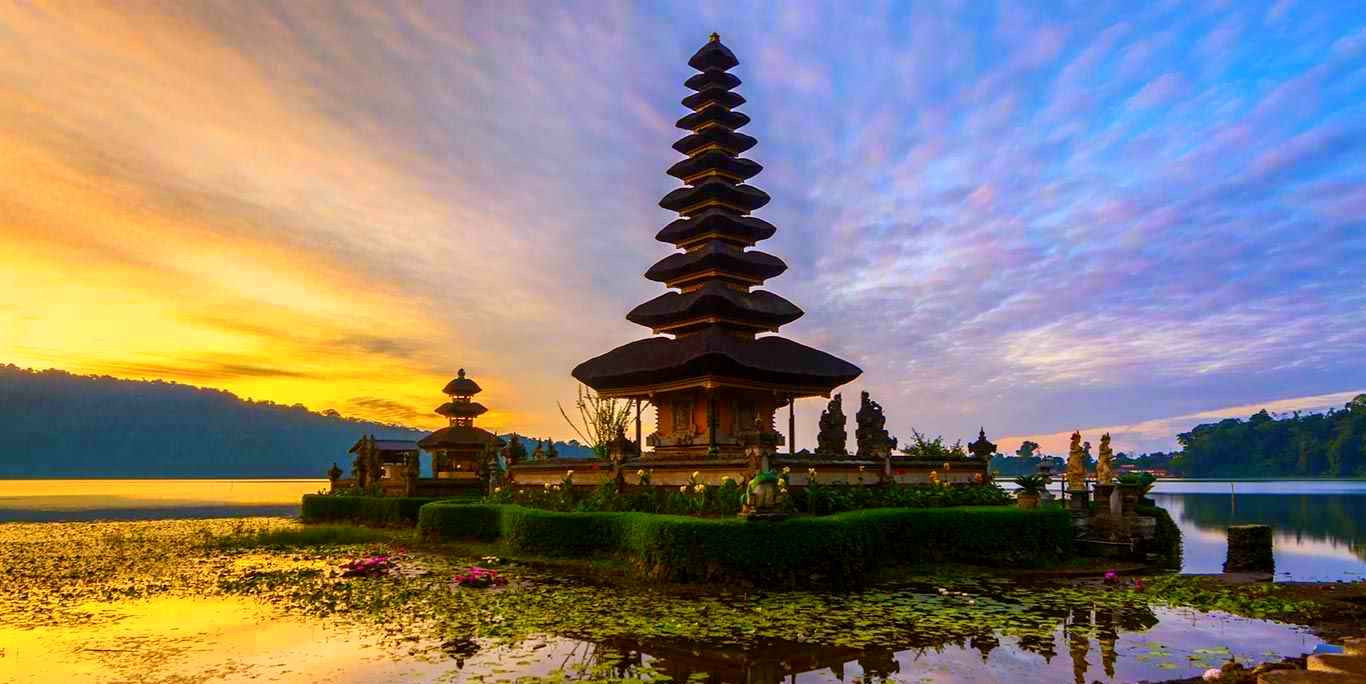
Historical Significance
-
Dedication: The temple complex is dedicated to Dewi Danu, the goddess of the lake, which is the main source of irrigation in central Bali.
-
Water Temple: As a significant water temple, it plays an important role in the Balinese subak system (the communal irrigation system that dates back to the 9th century).
Tourism and Activities
-
Scenic Beauty: The temple's reflection on the lake, the cool climate, and the mountainous backdrop make it a favored spot for photography and sightseeing.
-
Boating: Visitors can enjoy a boat ride on Lake Bratan and take in the views of the temple from different perspectives.
-
Gardens and Parks: The surrounding area includes well-maintained gardens, which provide a peaceful setting for a leisurely walk.
Conservation Efforts
Religious Practices
-
Ceremonial Importance: The temple is a site for ceremonies and festivals related to agriculture, especially to ensure a plentiful water supply and a good harvest.
-
Spiritual Significance: Its serene setting is thought to bring a sense of peace, connecting visitors and worshippers with the divine.
Visitor Information
-
Dress Code: Respectful clothing is expected; sarongs and sashes should be worn when entering temple grounds.
-
Entrance Fees: There is an admission fee for tourists, which is typically used for the maintenance of the temple and the surrounding areas.
-
Weather Considerations: Given its highland location, the climate can be cooler and mistier than in the lowlands, so dressing accordingly is recommended.
Pura Ulun Danu Bratan is not only a significant religious site but also a cultural emblem of Bali. Its setting on Lake Bratan makes it unique among the island's temples, often resulting in a mystical atmosphere as the mist rolls in over the water. It symbolizes the Balinese relationship with nature and the importance of water in their agricultural practices, integrating spiritual, cultural, and natural elements.
Besakih Temple
Besakih Temple, referred to as Pura Besakih, is the largest and holiest temple of Hindu religion in Bali, and one of a series of Balinese temples. Perched nearly 1000 meters up the side of Mount Agung, it is an extensive complex of 23 separate but related temples with the largest and most important being Pura Penataran Agung. The temple is a unique and majestic site of stepped terraces and expansive courtyards, adorned with numerous pagoda-like structures and shrines.
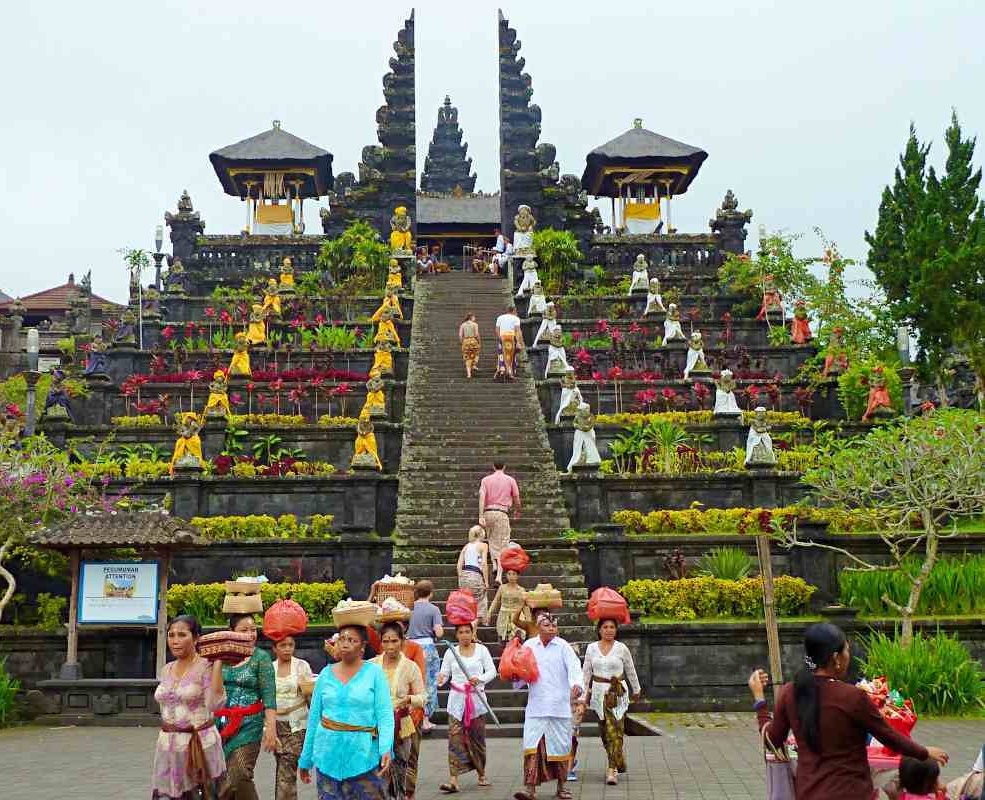
Historical Significance
-
Mother Temple: Often called the "Mother Temple of Bali," Pura Besakih is the most important, the largest, and the holiest temple complex in Bali.
-
Ancient Origins: The origins of the temple date back to prehistoric times, around 2000 years ago. The stone bases of Pura Penataran Agung are thought to date back to at least the 11th century.
-
Spiritual Axis: It is considered the axis mundi, the central point providing a connection between the physical and spiritual worlds, and is built on six levels, terraced up the slope.
Tourism and Activities
-
Pilgrimage Site: The complex is a destination for pilgrimages and features over 70 festivals a year.
-
Cultural Insight: Visiting Besakih offers a deep insight into the spiritual and communal life of the Balinese.
-
Scenic Views: The temple's high altitude offers breathtaking views of the surrounding area, including rice fields, hills, mountains, and streams.
Conservation Efforts
-
UNESCO Consideration: It has been nominated as a UNESCO World Heritage Site, which highlights its significance and the ongoing efforts to preserve the site.
-
Environmental Challenges: Besakih has withstood volcanic eruptions, including a major one in 1963, which have shaped its current conservation efforts.
Religious Practices
-
Complex Rituals: The complex is known for its complex ritual system and hierarchy of priests and attendants.
-
Anniversary Celebrations: Each temple in the complex has its own odalan, or anniversary celebration, based on the 210-day Balinese Pawukon calendar.
Visitor Information
-
Dress Code: Visitors need to adhere to a strict dress code, requiring a sarong and sash, which can usually be rented at the entrance.
-
Guides: Local guides are available and often insisted upon, which can be a point of contention among tourists due to aggressive sales tactics.
-
Entrance Fees: There is a fee for admission, which contributes to the temple’s upkeep.
Pura Besakih is more than just a tourist attraction; it is a central hub of Balinese Hinduism, a place of worship, and a site that connects the Balinese people to their gods and to the majesty of Mount Agung. Its multi-tiered thatch-roofed shrines, split gates, and stone dragon staircases are enveloped in an atmosphere of profound spirituality.
Goa Gajah
Goa Gajah, or the Elephant Cave, is an archaeological site of significant historical value located on the island of Bali, near Ubud. Despite its name, the cave has no association with elephants; rather, it is thought that the name may have originated from the stone figure of Ganesh (a Hindu god with an elephant's head) located inside the cave. The complex dates back to the 9th century and is a testament to the historical blending of Hindu and Buddhist influences in Indonesia.
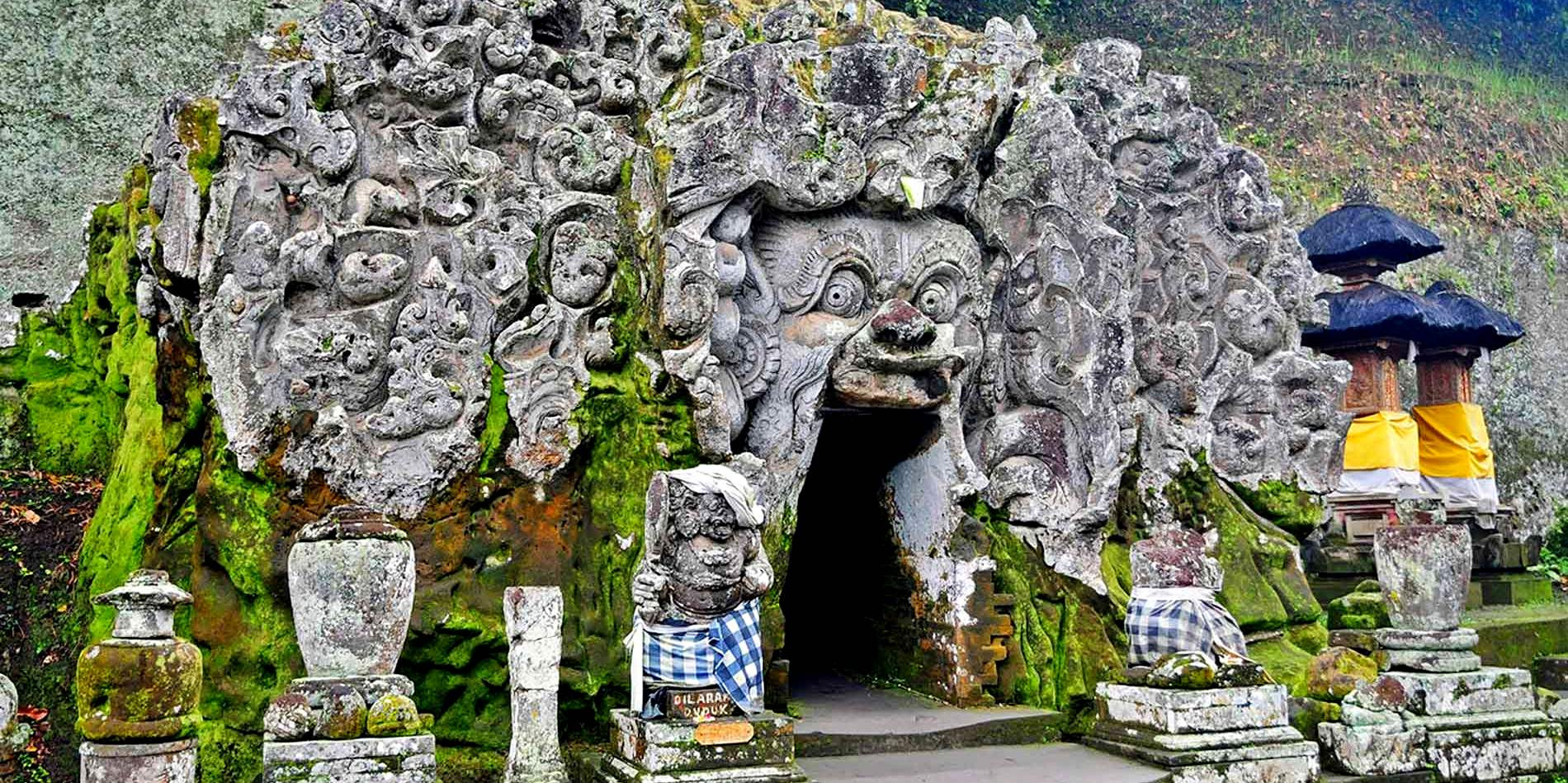
Historical Significance
-
Origins: Believed to be created in the 9th century as a spiritual place for meditation.
-
Cultural Intersection: The site contains elements of both Hindu and Buddhist imagery, reflecting the religious history of the region.
Tourism and Activities
-
Exploration: Visitors can explore the cave, the courtyard, rock-wall carvings, bathing pools, fountains, and various relics.
-
Cultural Appreciation: The relief carvings and the meditative atmosphere provide a glimpse into the spiritual practices of ancient Java.
Conservation Efforts
-
Preservation Work: The site has undergone several restoration efforts to preserve the integrity of the carvings and structures.
-
UNESCO Site: As part of the Cultural Landscape of Bali Province, it is recognized and protected as a UNESCO World Heritage site.
Religious Practices
-
Hindu and Buddhist Traditions: The cave was historically used for meditation and prayer, with evidence of both Hindu and Buddhist altars and imagery.
-
Modern Rituals: It remains a site of spiritual significance and is still used for religious practices today.
Visitor Information
-
Dress Code: Visitors should dress modestly; sarongs and sashes may be required and can usually be borrowed at the site.
-
Accessibility: Goa Gajah is located close to Ubud, making it easily accessible for tourists staying in the area.
-
Entrance Fees: A nominal entry fee is charged, contributing to the site's maintenance.
Goa Gajah is an intriguing destination for those interested in archaeology, history, and religion. The site offers a window into the past where architecture and spirituality intersect, allowing visitors to explore Bali's rich historical tapestry. While it may not be as grandiose as some other temple complexes, its significance lies in the detail and atmosphere that has been preserved over hundreds of years.
Tirta Empul Temple
Tirta Empul Temple, known as Pura Tirta Empul, is a Hindu Balinese water temple located near the town of Tampaksiring, Bali, Indonesia. The temple compound consists of a petirtaan or bathing structure, famous for its holy spring water, where Balinese Hindus go to for ritual purification. The temple pond has a spring that gives out fresh water regularly, which Balinese Hindus consider to be holy or amrita. Here are some significant details about Tirta Empul Temple:
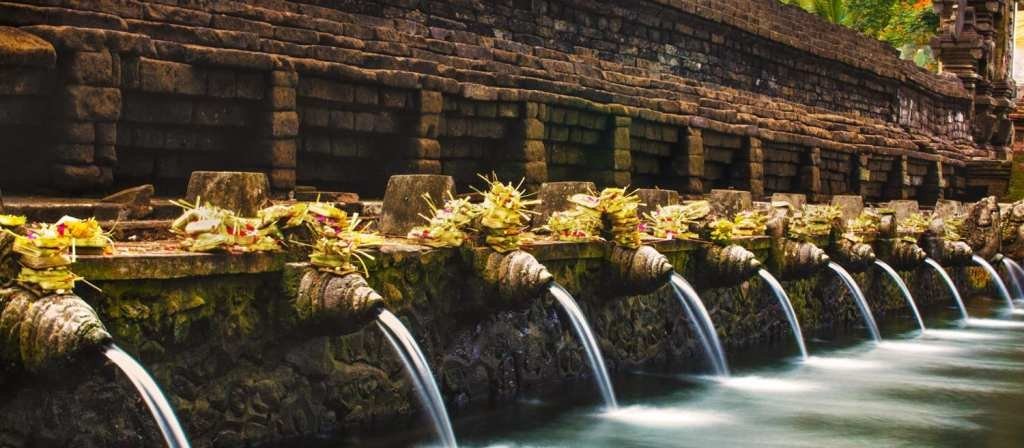
Historical Significance
-
Origins: Tirta Empul means 'holy water spring' in Balinese, a name given to the water source located within the temple. The temple is believed to have been created around a large water spring in 962 AD.
-
Spiritual Cleansing: The spring feeds various purification baths, pools, and fish ponds surrounding the outer perimeter, which then flow to the Tukad Pakerisan River.
Tourism and Activities
-
Purification Rituals: Tourists can participate in the purification ritual, known as 'melukat,' by entering the pools and dipping their heads under the water spouts.
-
Cultural Experience: The site offers a serene atmosphere and the chance to observe Balinese Hindus engaging in their spiritual rites, providing visitors with a sense of the cultural importance of water in Balinese Hinduism.
Conservation Efforts
-
Heritage Site Maintenance: Efforts are continually made to maintain the temple's integrity, both in its physical structure and its spiritual significance, amidst the pressures of tourism.
-
Water Quality: With the increase in visitors, there is an ongoing concern and effort to keep the waters clean and the natural surroundings protected.
Religious Practices
Visitor Information
-
Dress Code: Respectful attire is required. Sarongs and sashes can be rented or are sometimes provided at the temple.
-
Guidelines for Rituals: If participating in purification rituals, it is essential to follow the temple’s guidelines to respect religious customs.
-
Entrance Fees: There is typically a nominal fee to enter the temple, which helps fund its upkeep.
Tirta Empul Temple is a place where the physical and the spiritual meet, where the waters are not only seen as a natural resource but also as a divine gift that cleanses and rejuvenates. It's a profound cultural touchstone for the Balinese and an enriching experience for visitors seeking insight into the island's spiritual traditions.
Pura Taman Ayun Temple
Pura Taman Ayun is a compound of Balinese temple and garden with water features located in Mengwi, Badung Regency, Bali, Indonesia. It is an important cultural landmark and a historical piece of Balinese architecture and heritage. Here is an overview of Pura Taman Ayun:
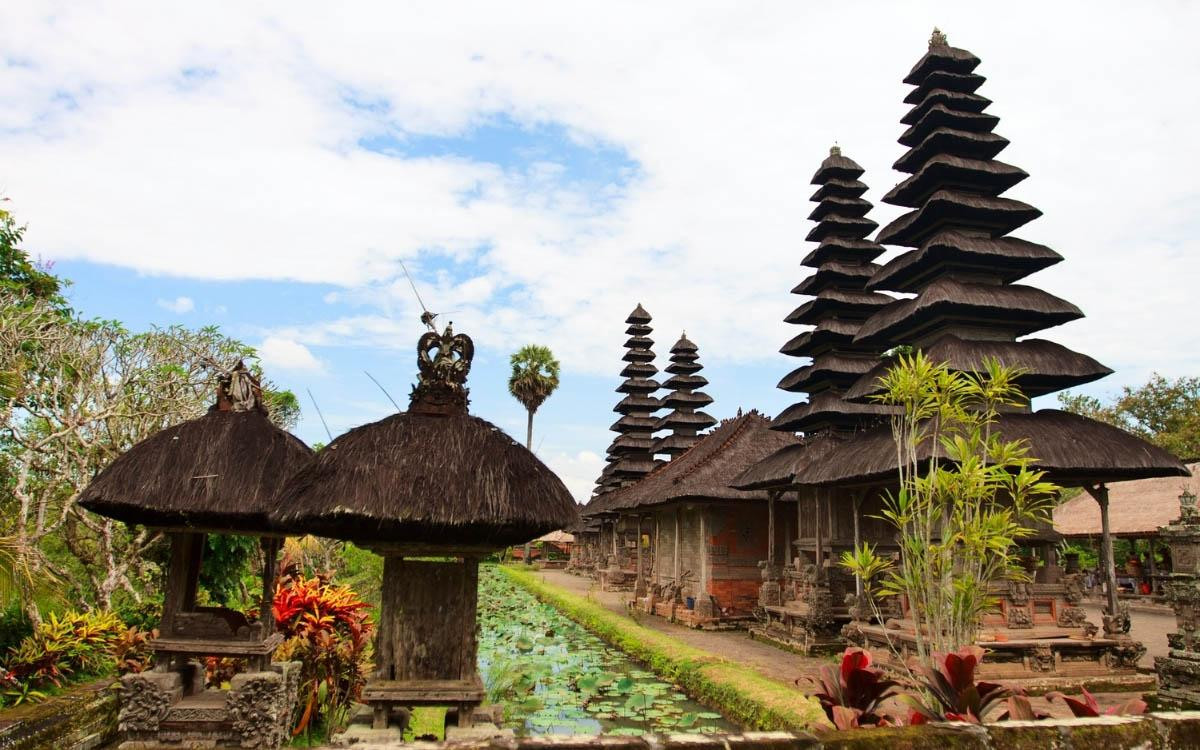
Historical Significance
-
Royal Temple: Built in the 1630s by the Raja of Mengwi, Taman Ayun served as the main temple of the Mengwi kingdom, which survived until 1891.
-
Architectural Marvel: The temple's multi-tiered shrines (meru), and expansive gardens are classic examples of Balinese temple architecture combined with elements of Chinese architecture.
Tourism and Activities
-
Scenic Beauty: The temple's tranquil gardens, expansive fish ponds, and beautiful merus make it a peaceful and picturesque site for visitors.
-
Cultural Insight: Exploring Pura Taman Ayun offers insight into the Mengwi kingdom's history and the architectural evolution of Balinese temples.
Conservation Efforts
-
UNESCO Recognition: The temple complex was inscribed on UNESCO's World Heritage List in 2012, as part of the Cultural Landscape of Bali Province, ensuring international recognition and conservation efforts.
-
Maintenance: Regular upkeep is carried out to preserve the temple's structures, gardens, and water features.
Religious Practices
-
Religious Significance: Pura Taman Ayun remains an important site for worship and ceremonies, particularly for the descendants of the former Mengwi royal family.
-
Festivals and Ceremonies: The temple celebrates its piodalan, or temple anniversary, which falls every 210 days on the Balinese calendar.
Visitor Information
-
Dress Code: Visitors are expected to respect the sacred nature of the temple. Wearing a sarong and sash is compulsory for those entering the temple grounds.
-
Entrance Fee: A small fee is typically charged to enter the temple, contributing to its maintenance and preservation.
-
Guided Tours: Guided tours are often available to provide informative background and cultural context for visitors.
Pura Taman Ayun is not only a picturesque site but also a place rich in cultural and spiritual significance. It represents the historical values and the aesthetic principles of the Balinese with its impressive traditional architectural features, expansive landscape design, and historical importance. It stands as a tranquil reminder of Bali's regal past and its continuous cultural and religious traditions.
Goa Lawah Temple
Goa Lawah Temple, known as Pura Goa Lawah, is a significant Hindu temple located on the southeast coast of Bali, Indonesia. The temple is one of the island's most unique sanctuaries, featuring a complex built around a cave opening that is inhabited by hordes of bats, and hence its name, which translates to 'Bat Cave Temple.'
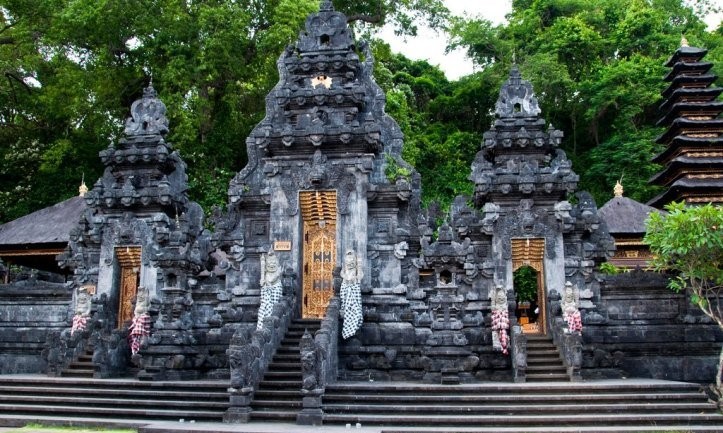
Historical Significance
-
Cave Sanctuary: The cave is believed to be inhabited by a giant dragon-like snake called Basuki, a mythical beast in Balinese Hindu mythology.
-
Early Founding: Dating back to the 11th century, it is one of Bali's key nine directional temples and is of great significance for the Balinese in terms of spiritual and directional balance.
Tourism and Activities
-
Cave Exploration: Visitors are often fascinated by the sight of the bats and the cave itself, which is considered to be a natural wonder.
-
Cultural Insight: The temple provides an opportunity to observe Balinese Hindu rituals that have been practiced for centuries.
Conservation Efforts
-
Wildlife Protection: The bats are considered guardians of the temple and are protected as part of the temple's religious significance.
-
Cultural Preservation: Efforts are made to maintain the temple as a historical site, preserving its structures and the rituals performed there.
Religious Practices
-
Ceremonial Site: Pura Goa Lawah is an important site for various ceremonies and is especially significant for post-cremation purification ceremonies for the Balinese people.
-
Pilgrimage Destination: Many pilgrims visit the temple before they go to other important religious sites, such as Pura Besakih.
Visitor Information
-
Dress Code: As with other Balinese temples, a proper dress code is enforced. Visitors are expected to wear a sarong and a sash, which are often available for rent at the temple.
-
Respect Wildlife: While visitors can observe the bats, they are advised to do so respectfully and without disturbing them.
-
Entrance Fees: A small fee is typically charged for entry, which is used for the upkeep of the temple and its surroundings.
Pura Goa Lawah offers a rare combination of natural and cultural attractions. It stands out not only for its spiritual importance but also for the natural phenomenon of the bat habitat within the temple complex. The temple's role in Balinese culture is both mystical and practical, with the presence of the bats considered to be a living testament to the temple's sanctity.
Lempuyang Temple (Pura Lempuyang Luhur)
Pura Lempuyang Luhur, more commonly known as Lempuyang Temple, is one of Bali's oldest and most venerated temples. It is also considered to be one of the six most important temples in Bali, the Sad Kahyangan Jagad, which are meant to protect the island from evil spirits. Located at the peak of Mount Lempuyang in East Bali, this temple offers a blend of spiritual significance and breathtaking natural beauty.
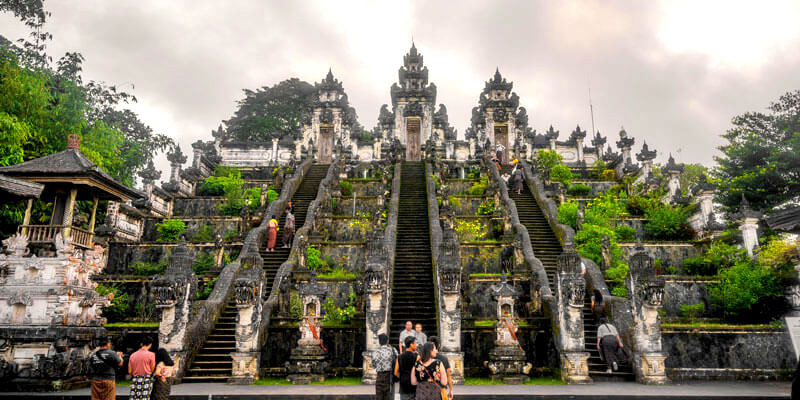
Historical Significance
Tourism and Activities
-
Iconic Gates: The "Gateway to Heaven," also known as the split gate (Candi Bentar), provides a picturesque view, framing Mount Agung and is a highly Instagrammable spot.
- Climb to the Top: A significant aspect of a visit to Lempuyang Temple is the 1,700-step climb to reach the temple, which is not only a physical challenge but also a spiritual pilgrimage.
Conservation Efforts
Religious Practices
Visitor Information
Visiting Pura Lempuyang Luhur is a highly rewarding experience that offers not just a spiritual journey but also a chance to witness some of the most stunning panoramic views in Bali. The temple reflects the Balinese philosophy of harmony between the environment, humanity, and the spiritual realm.
Saraswati Temple
Pura Taman Saraswati, commonly known as Saraswati Temple, is a beautiful water temple in the heart of Ubud, Bali, dedicated to the Hindu goddess Saraswati, the deity of learning, literature, and art. This temple is particularly famed for its stunning lotus pond and classical Balinese temple architecture featuring intricate carvings.
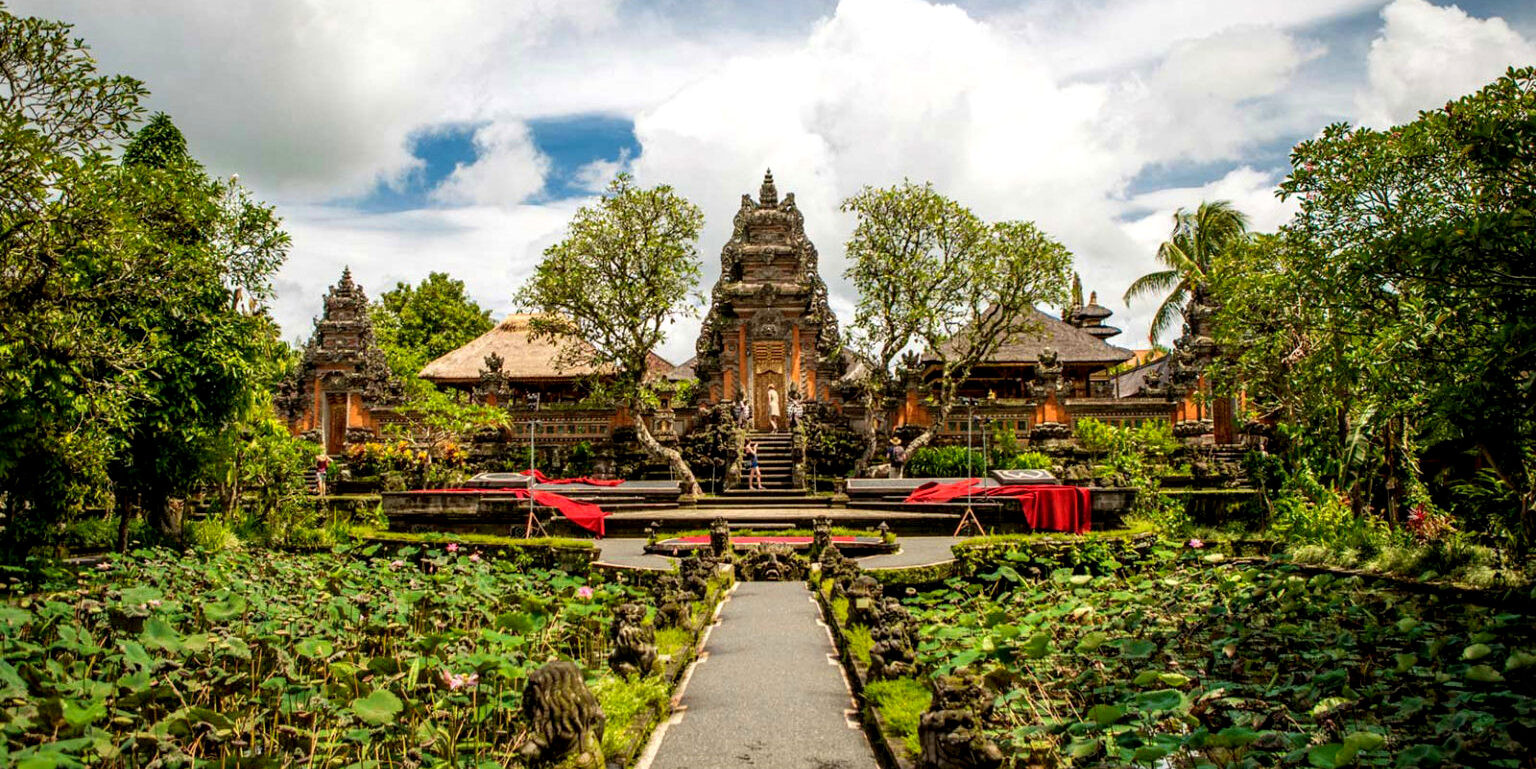
Key Features of Saraswati Temple:
-
Architecture: The temple showcases traditional Balinese architecture adorned with elaborate carvings and statues of Saraswati.
-
Lotus Pond: Before reaching the temple, visitors are greeted by a pond filled with blooming lotus flowers, symbolizing purity and enlightenment.
-
Cultural Performances: Saraswati Temple is known for hosting Balinese dance performances in the evenings, which take place on a stage set against the temple backdrop.
-
Central Location: Located in central Ubud, it's easily accessible and often included in a walking tour of the town, near the Ubud Palace and the famous Ubud Market.
Cultural and Religious Significance:
-
Dedication to Goddess Saraswati: The temple is a tribute to the goddess of knowledge and arts, making it a revered site for those seeking wisdom and artistic inspiration.
-
Festivals: Saraswati Day is celebrated every 210 days according to the Balinese Pawukon calendar, with offerings made to the goddess, prayers, and religious rituals.
Visiting the Temple:
-
Dress Code: Visitors should dress respectfully, with sarongs required to enter the temple area. These are usually available for rent or provided at the entrance.
-
Entrance Fee: Access to the temple grounds is generally free, but donations are appreciated.
-
Photography: It's a popular site for photography, thanks to its picturesque setting and the serene atmosphere around the lotus pond.
Pura Taman Saraswati stands as a cultural beacon in Ubud, reflecting the town's dedication to preserving and celebrating Balinese arts and literature. The temple's serene ambiance, combined with its cultural activities, makes it a place where both the local community and visitors can enjoy the beauty of Balinese culture in a spiritual setting.
Tips and considerations while visiting temples in Bali
Visiting temples in Bali is a highlight for many travelers due to the island's rich spiritual heritage. However, there are important cultural norms and rules of etiquette to observe when visiting these sacred spaces. Here are some tips and considerations:
Dress Appropriately
-
Cover Up: Shoulders and knees should be covered. This is a sign of respect in Balinese culture.
-
Sarong and Sash: Most temples require visitors to wear a sarong and a sash. These are often available for rent or sometimes included in the entrance fee at the more popular temples.
Behave Respectfully
-
Quiet and Calm: Speak in a low voice and avoid loud noises. Temples are places of worship and reflection.
-
Follow the Rules: Pay attention to signs that may indicate where you can and cannot go, especially during religious ceremonies.
During Religious Ceremonies
-
Do Not Interfere: Do not walk in front of people when they are praying.
-
Photography: Ask for permission before taking photos of the locals, especially during ceremonies.
-
Offerings: Do not touch or step over offerings (canang sari) scattered around the temple grounds.
Temple Etiquette
-
Entrance: Some temples have different entrances for worshipers and tourists. Be sure to use the correct one.
-
Direction: Always walk clockwise around the central shrines if you're following the ritual path.
-
Heads and Feet: Do not touch the heads of locals, as it is considered disrespectful. Likewise, do not point your feet towards the shrines as feet are considered the lowest and dirtiest part of the body.
Health and Safety
-
Monkeys: Be cautious with belongings at temples like Uluwatu where monkeys are present, as they can snatch glasses, jewelry, or cameras.
-
Hydration: Bali is hot, so drink plenty of water to avoid dehydration, especially when walking around temple complexes.
Environmental Considerations
-
Littering: Keep the temple grounds clean by not littering. Use the designated trash bins for your waste.
-
Natural Features: Do not damage or remove any part of the natural surroundings, such as flowers or stones.
Interaction with Locals
-
Courtesy: If you want to join in a ceremony or observe up close, always ask permission. Most Balinese people are very welcoming and will be happy to include you if possible.
-
Language: Learning a few words of Bahasa Indonesia or Balinese, such as "Terima Kasih" (thank you), can go a long way.
Monetary Considerations
-
Entrance Fees: Be prepared to pay a small entrance fee at some temples, which goes towards maintenance.
-
Donations: You may wish to make a donation, especially if a temple is particularly small or less frequented by tourists.
General Tips
-
Guide: Consider hiring a local guide who can explain the significance of the temple and the ceremonies taking place. This can enrich your understanding of Balinese culture.
-
Sun Protection: Wear a hat and sunscreen to protect yourself from the sun, particularly in open areas with little shade.
Remember, Balinese temples are not just tourist attractions but active places of worship. Demonstrating respect for local customs and religious practices is essential when visiting these sacred sites.
Best Time to Visit Temples in Bali
Bali's tropical climate means it doesn't have the four seasons found in temperate zones; instead, it has two main seasons: the dry season and the wet season. Here's a breakdown:
Dry Season (May to September)
-
Weather: This is the cooler part of the year, although temperatures remain warm (around 27°C or 80°F), with low humidity and little rain, making it the most comfortable time to visit.
-
Activities: Ideal for outdoor activities such as hiking, beach days, diving, and attending cultural events.
-
Tourism Peak: July and August are the busiest months, with domestic and international tourists. Expect crowds and higher prices.
Wet Season (October to April)
-
Weather: The wet season brings higher humidity and daily downpours that are usually intense but short. Temperatures are a bit higher, averaging around 30°C (86°F).
-
Activities: It's still possible to enjoy your vacation, but outdoor activities may be interrupted by rain. It’s a good time for indoor activities like spa treatments, yoga, or cooking classes.
-
Advantages: Fewer tourists, lush landscapes, and lower prices for accommodation.
"Shoulder" Periods
While not traditional seasons, these periods are transitional times that can offer the advantages of both main seasons.
Post-Dry Season (October)
-
Transitional Weather: Early October may still have some of the dry season's characteristics, with less rain and fewer tourists than the peak season.
-
Activities: Water sports and outdoor activities are still enjoyable, and there's better access to attractions without the peak season crowds.
Pre-Wet Season (March to April)
-
Transitional Weather: The wet season is tapering off, so there's less rainfall and humidity begins to decrease.
-
Activities: The landscape is still verdant from the wet season, and there's more sunshine, allowing for pleasant beach days and sightseeing.
Keep in mind that temple visits are feasible all year, although the weather might influence your experience. Bali doesn't experience the traditional spring, summer, autumn, and winter seasons, but the variations within the dry and wet seasons can provide different kinds of experiences that are somewhat akin to having different seasons. Visitors often prefer the dry season for its sunny weather and outdoor activities, while the wet season can appeal to those looking for fewer crowds and a more relaxed trip with the chance to enjoy Bali's natural beauty at its most lush.
Finally, the top ten temples in Bali are more than simply architectural wonders; they are windows into the heart and spirit of the island. Consider visiting during the dry season to ensure a more pleasant and scenic experience while you explore these sites.
Local customs and decorum must be followed at all times. Dress modestly, abide by the restrictions, and respect the hallowed character of these locations. The temples are sites where spirituality, culture, and natural beauty all come together in perfect harmony.
As you go through these sacred sites, whether to view breathtaking sunsets, participate in ceremonies, or just find moments of peace, you'll realise that Bali's temples provide a deeper connection to the island's spiritual and cultural core. Your visit to these landmarks is certain to leave an indelible impression on you, reminding you of the island's rich history long after you've left its shores.
Culturally Sublime Bali Tour
If you are looking for different kinds of travel Packages, feel free to contact us
